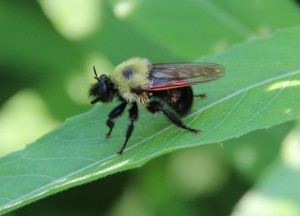Who wants to be a bee? I don’t claim to know the deepest desires of insects that visit our gardens and farms, except that they want to survive, eat and reproduce. So why do so many mimic other insects that are dangerous, such as yellowjackets? The black and yellow stripes of a typical yellowjacket are easily recognizable to birds, humans and other mammals and signal “Danger! I sting!”. That’s a pretty powerful message that ensures yellowjackets and other wasps and bees are avoided by hungry predators looking to raid the colony for tasty larvae or honey. It’s called aposematic coloration and serves as a warning to other animals not to mess around. From skunks to poison arrow frogs to snakes, aposematic coloration protects both predator and prey from unfortunate interactions.
But what about the harmless insects that are similarly colored? In landscapes and gardens throughout the U.S. you can look closely and find small black and yellow-striped insects

hovering above flowers. Harmless hover flies (a type of fly in the Syrphid family) display a mimicry of yellowjacket coloration, as you can see in the picture. Adults hover flies feed on nectar and pollen, thereby serving as minor pollinators of many flowering plants. The larvae, or maggots, of some hover flies are saprotrophs (feeding on decaying matter) and some are predatory on smaller insects, like aphids and thrips. Aphids, alone, cause tens of millions of dollars in crop damage each year. Hover flies are considered among the many important natural enemies of aphids and other plant-feeding pests. A gardener’s friend, indeed!

Also in the Order Diptera (which includes all flies and mosquitoes) are the amazing robber flies. The one pictured is called a bee-mimic robber fly. It closely resembles a bumble bee and enjoys the protection that such mimicry provides. How could you tell it apart from a bumble bee? All flies, including these, have only one pair of wings. Look closely at the image and you can see a round dot at the base of the wing. That is called a haltere, which is a wing reduced into a flight stabilizer. You can also see very enlarged eyes, relative to the head, small V-shaped antennae and a thick straw-like mouth. Yes, robber flies can bite! But they are voracious predators of other insects – whatever they can catch. Although robber flies are indiscriminate about what other insects they eat, if you have a garden with pests and you see robber flies, they are probably doing good deeds for you.
By looking closely at the many insects that visit your yard and garden, you might be surprised at how many beneficial insects you see. Maintaining your green space using fewer pesticides and incorporating IPM strategies to manage plant feeders will help protect these amazing natural enemies.